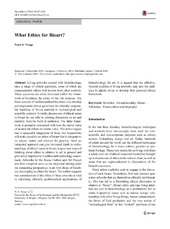What Ethics for Bioart?
| dc.contributor.author | Vaage, Nora Sørensen | |
| dc.date.accessioned | 2016-07-05T12:02:51Z | |
| dc.date.available | 2016-07-05T12:02:51Z | |
| dc.date.issued | 2016-04 | |
| dc.Published | NanoEthics 2016, 10(1):87-104 | eng |
| dc.identifier.issn | 1871-4765 | |
| dc.identifier.uri | https://hdl.handle.net/1956/12272 | |
| dc.description.abstract | Living artworks created with biotechnology raise a range of ethical questions, some of which are unprecedented, others well known from other contexts. These questions are often discussed within the framework of bioethics, the ethics of the life sciences. The basic concern of institutionalised bioethics is to develop and implement ethical guidelines for ethically responsible handling of living material in technological and scientific contexts. Notably, discussions of ethical issues in bioart do not refer to existing discourses on art and morality from the field of aesthetics. The latter framework is primarily concerned with how the moral value of an artwork affects its artistic value. The author argues that a successful integration of these two frameworks will make possible an ethics of bioart that is adequate to its subject matter and relevant for practice. Such an integrated approach can give increased depth to understandings of ethical issues in bioart, inspire new ways of thinking about ethics in relation to art in general and give novel impulses to bioethics and technology assessment. Artworks by the Tissue Culture and Art Project and their reception serve as the empirical starting point for connecting perspectives in art with those of bioethics, developing an ethics for bioart. The author suggests that consideration of the effect of these artworks is vital in validating ethically problematical applications of biotechnology for art. It is argued that the affective, visceral qualities of living artworks may spur the audience to adjust, revise or develop their personal ethical framework. | en_US |
| dc.language.iso | eng | eng |
| dc.publisher | Springer | eng |
| dc.relation.ispartof | <a href="http://hdl.handle.net/1956/12674" target="_blank">Amplifying Ambiguities. Art on the Fringes of Biotechnology</a> | |
| dc.rights | This article is distributed under the terms of the Creative Commons Attribution 4.0 International License (http://creativecommons.org/licenses/by/4.0/), which permits unrestricted use, distribution, and reproduction in any medium, provided you give appropriate credit to the original author(s) and the source, provide a link to the Creative Commons license, and indicate if changes were made. | eng |
| dc.rights.uri | https://creativecommons.org/licenses/by/4.0/ | eng |
| dc.subject | Bioethics | eng |
| dc.subject | Art and morality | eng |
| dc.subject | Bioart | eng |
| dc.subject | Validation | eng |
| dc.subject | Tissue culture and art project | eng |
| dc.title | What Ethics for Bioart? | eng |
| dc.type | Journal article | eng |
| dc.type | Peer reviewed | eng |
| dc.date.updated | 2016-06-03T09:15:47Z | |
| dc.description.version | publishedVersion | |
| dc.rights.holder | Copyright The Author(s). | eng |
| dc.identifier.doi | https://doi.org/10.1007/s11569-016-0253-6 | |
| dc.identifier.cristin | 1359432 | |
| dc.subject.nsi | VDP::Humaniora: 000::Filosofiske fag: 160::Etikk: 164 |
Files in this item
This item appears in the following Collection(s)
Except where otherwise noted, this item's license is described as This article is distributed under the terms of the Creative Commons Attribution 4.0 International License (http://creativecommons.org/licenses/by/4.0/), which permits unrestricted use, distribution, and reproduction in any medium, provided you give appropriate credit to the original author(s) and the source, provide a link to the Creative Commons license, and indicate if changes were made.

